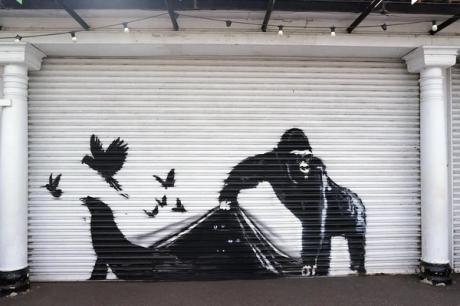
Following street artist Banksy’s recent animal art onslaught across different sites in London, the question now on everyone’s lips is—what will happen to the nine works? First, a quick recap: a goat, two elephants, three swinging monkeys, a howling wolf, a stretching cat, pelicans, a shoal of piranhas painted onto the glass of a police sentry box near the Old Bailey in central London, a car-mounting rhino and finally a gorilla seemingly leading a mass escape from London Zoo.
The wolf, daubed onto a satellite dish in Peckham, has already been nicked by a group wearing balaclavas. Meanwhile the sentry box has been relocated to Guildhall Yard, “to ensure it is properly protected and open for the public to view safely”, according to the City of London Corporation. The stretching cat latested just a few hours before it was removed by contractors who feared for its safety.
But commentators are still wondering about the fate of the other beastly pieces, especially the gorilla art at London Zoo. “What will be done with the art? Will it be preserved and displayed? Sold to raise funds for the ZSL [Zoological Society of London]?” asked one commentator on the social media platform X. The zoo responded: “we’re still working on exactly what we’re going to do with the artwork, but we’re keen to properly preserve this moment in our history!”.
Selling the piece would no doubt ensure a cash bonanza for the animal sanctuary, which needs almost £60m annually for research and conservation—Banksy’s auction record stands at £18.5m with fees for Love is in the Bin, 2018, sold at Sotheby’s London in 2021. According to The Guardian, officials have now replaced the work with a replica and a nearby sign that reads “Banksy woz ere”, giving fans the chance to see at least enjoy a reproduction of the gorilla (or guerrilla) art.


